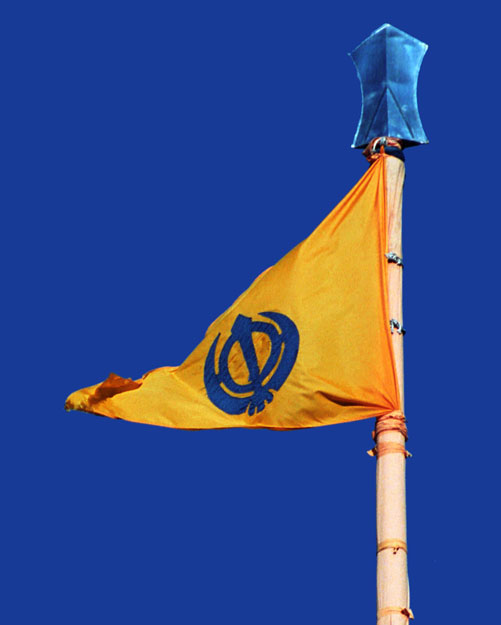Nishan Sahib

The Nishan Sahib is a Sikh holy triangular flag made of cotton or silk cloth, with a tassel at its end. The word, Nishan means symbol, and the flag is hoisted on a tall flagpole, outside most Gurdwaras just like at the Gurdwara Singh Sabha of Michigan. The flagpole itself covered with fabric, ends with a two-edged dagger (khanda) on top. The emblem on the flag, which depicts a double-edged sword called a khanda (☬) in the centre, a chakkar which is circular, and flanked by two single-edged swords, or kirpans.
Traditional symbol of the Khalsa Panth, the Nishan Sahib can be seen from far away, signifying the presence of Khalsa in the neighbourhood. The Khanda is one of most important symbols of Sikhism alongside the Ik Onkar. The khanda is like a coat of arms for Sikhs. It was introduced by the sixth Guru, Guru Hargobind. It is an amalgam of three symbols, represented by three different items. It is commonly found on the Nishan Sahib or flag of the Sikhs, anywhere in a Gurudwara. There are three different items used in a Khanda, which also have a symbolic meaning: A double-edged sword called a Khanda in the centre, A Chakkar which is circular, Two single-edged swords, or kirpans, are crossed at the bottom and sit on either side of the Khanda and Chakkar. They represent the two characteristics, one being Miri (Temporal power) and the other, Piri (Spirituality). In the symbol the sword to the left represents truth, and the sword to the right represents the willingness to fight for what is right – dharma (religion). The circle in the middle means that there is only one God, never beginning and never ending. The Khanda represents knowledge of God, the Chakkar represents the eternal nature of God and oneness of humanity, the two swords represent Miri (political sovereignty) and Piri (spiritual sovereignty).
